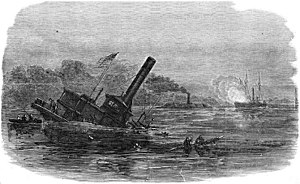USS Southfield

USS Southfield, sinking after a battle with CSS Albemarle
|
|
| History | |
|---|---|
|
|
|
| Name: | USS Southfield |
| Builder: | John English, Brooklyn |
| Launched: | 1857 |
| Commissioned: | December 1861 |
| Decommissioned: | April 1864 |
| Fate: | Sunk by CSS Albemarle, 19 April 1864 |
| General characteristics | |
| Type: | Sidewheel gunboat |
| Displacement: | 750 long tons (762 t) |
| Length: | 200 ft (61 m) |
| Beam: | 34 ft (10 m) |
| Draft: | 6 ft 6 in (1.98 m) |
| Depth of hold: | 11 ft 8 in (3.56 m) |
| Propulsion: | Steam engine |
| Speed: | 12 knots (22 km/h; 14 mph) |
| Complement: | 61 officers and men |
| Armament: |
|
USS Southfield was a double-ended, sidewheel steam gunboat of the Union Navy during the American Civil War. She was sunk in action against the Confederate ironclad ram CSS Albemarle during the Battle of Plymouth (1864).
Southfield was built in 1857 at Brooklyn, New York by John English, and served as a ferry between South Ferry, New York, and St. George, Staten Island, until she was purchased by the U.S. Navy at New York City on December 16, 1861 from the New York Ferry Company. She was commissioned late in December 1861, Acting Volunteer Lieutenant Charles F. W. Behm in command.
The double-ended gunboat joined the North Atlantic Blockading Squadron at Hampton Roads on the afternoon of January 2, 1862. On January 11, Admiral Louis M. Goldsborough ordered Southfield to proceed to Hatteras Inlet, North Carolina, the staging area for an expedition against Roanoke Island, which controlled navigation in the North Carolina sounds. The gunboat was detained at Hampton Roads awaiting troops to fill out her complement until about sunset on January 16 when she got underway south. She reached Hatteras Inlet the next day.
Great labor was required to get Goldsborough's ships and the U.S. Army transports over Hatteras bar. The last vessel entered the sounds on February 5, enabling the expedition to get underway.
...
Wikipedia
